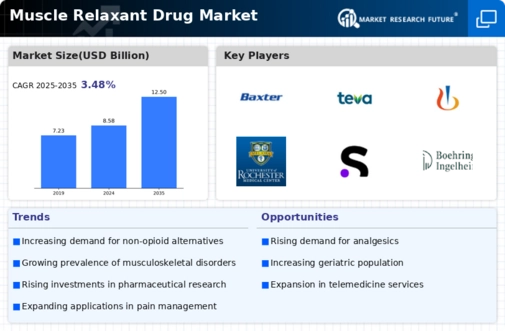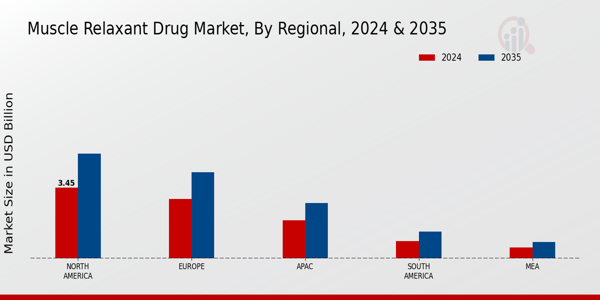Aging Population
The global population is aging, leading to an increased demand for healthcare services, including muscle relaxants. Older adults are more susceptible to conditions that require muscle relaxants, such as arthritis and other degenerative diseases. According to the United Nations, the proportion of the global population aged 65 and older is projected to double by 2050. This demographic shift is likely to result in a higher prevalence of musculoskeletal issues, thereby driving the demand for muscle relaxants. Consequently, the Global Muscle Relaxant Drug Market Industry is expected to see significant growth as healthcare providers seek effective solutions for this aging population.
Market Growth Projections
The Global Muscle Relaxant Drug Market Industry is projected to experience substantial growth over the coming years. With a market value of 8.58 USD Billion in 2024, it is anticipated to reach 12.5 USD Billion by 2035. This growth trajectory suggests a compound annual growth rate of 3.48% from 2025 to 2035. Such projections indicate a robust demand for muscle relaxants, driven by factors such as the increasing prevalence of musculoskeletal disorders and advancements in pharmaceutical research. The market's expansion reflects the ongoing need for effective treatment options that address the diverse needs of patients suffering from muscle-related conditions.
Regulatory Approvals and Market Access
The process of regulatory approvals for new muscle relaxants plays a crucial role in shaping the Global Muscle Relaxant Drug Market Industry. Streamlined approval processes and favorable regulatory environments can facilitate quicker access to innovative treatments. For instance, the U.S. Food and Drug Administration has been known to expedite the review of drugs that address unmet medical needs. Such regulatory support can enhance market dynamics by allowing new muscle relaxants to reach patients more rapidly. As a result, the industry may experience accelerated growth, driven by the introduction of novel therapies that meet the evolving needs of healthcare providers and patients.
Advancements in Pharmaceutical Research
Ongoing advancements in pharmaceutical research and development are likely to enhance the efficacy and safety profiles of muscle relaxants. Innovations in drug formulation and delivery methods could lead to the introduction of new muscle relaxants that offer improved therapeutic outcomes. For example, the development of extended-release formulations may provide longer-lasting relief for patients suffering from muscle spasms. Such advancements not only cater to the evolving needs of healthcare providers and patients but also stimulate growth within the Global Muscle Relaxant Drug Market Industry. As the market evolves, these innovations may contribute to a compound annual growth rate of 3.48% from 2025 to 2035.
Rising Awareness of Pain Management Options
There is a growing awareness among patients and healthcare providers regarding the importance of effective pain management strategies. This awareness is leading to an increased utilization of muscle relaxants as part of comprehensive pain management plans. Educational initiatives and campaigns aimed at informing patients about available treatment options are contributing to this trend. As more individuals seek relief from muscle spasms and associated pain, the Global Muscle Relaxant Drug Market Industry is likely to benefit from this heightened awareness. The market's growth trajectory is expected to align with the overall increase in demand for effective pain management solutions.
Increasing Prevalence of Musculoskeletal Disorders
The rising incidence of musculoskeletal disorders globally drives the Global Muscle Relaxant Drug Market Industry. Conditions such as chronic back pain, arthritis, and fibromyalgia are becoming increasingly common, affecting millions of individuals. For instance, the World Health Organization reports that musculoskeletal disorders are among the leading causes of disability worldwide. This growing patient population necessitates effective treatment options, including muscle relaxants, which are often prescribed to alleviate pain and improve mobility. As a result, the demand for muscle relaxants is expected to rise, contributing to the market's projected growth from 8.58 USD Billion in 2024 to 12.5 USD Billion by 2035.






















